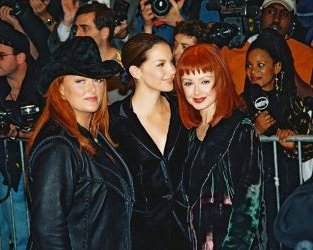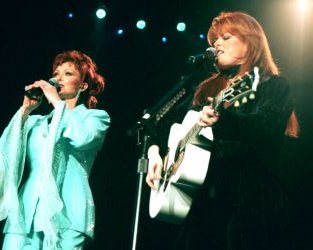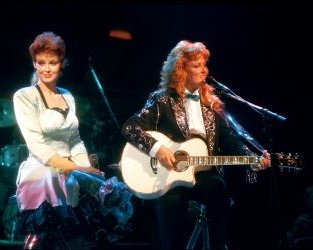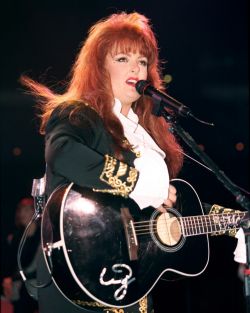| |
| |
| |
| |
| |
| |
| |
| |
The Judds.
 Up
until the rise of Brooks Dunn in the '90s, the Judds were the most commercially
successful duo in country music history. Mother Naomi and daughter Wynonna
enjoyed an astounding run of 14 number one singles from 1984 to 1989,
ranking them as one of the most popular country acts of the '80s. Their
music combined elements of traditional country harmony singing, bluegrass,
and Appalachian folk with pop, rock, and polished contemporary production.
Moreover, Wynonna's powerful, bluesy, often sexy lead vocals established
her as one of the finest female country singers of her era. But even more
important than their widely accessible sound -- or their considerable
visual appeal -- was their sympathetic understanding of working-class
and small-town women, earned through a long, hard struggle of their own.
Though their off-stage relationship was often more contentious than it
appeared, it took a life-threatening illness to bring the Judds to a halt
-- Naomi retired from performing when she was diagnosed with hepatitis
C but beat the disease to watch Wynonna enjoy an acclaimed solo career.
Up
until the rise of Brooks Dunn in the '90s, the Judds were the most commercially
successful duo in country music history. Mother Naomi and daughter Wynonna
enjoyed an astounding run of 14 number one singles from 1984 to 1989,
ranking them as one of the most popular country acts of the '80s. Their
music combined elements of traditional country harmony singing, bluegrass,
and Appalachian folk with pop, rock, and polished contemporary production.
Moreover, Wynonna's powerful, bluesy, often sexy lead vocals established
her as one of the finest female country singers of her era. But even more
important than their widely accessible sound -- or their considerable
visual appeal -- was their sympathetic understanding of working-class
and small-town women, earned through a long, hard struggle of their own.
Though their off-stage relationship was often more contentious than it
appeared, it took a life-threatening illness to bring the Judds to a halt
-- Naomi retired from performing when she was diagnosed with hepatitis
C but beat the disease to watch Wynonna enjoy an acclaimed solo career.
The Judds' story began in Ashland, KY, where Naomi was born Diana Ellen
Judd on January 11, 1946. An honor roll student, she often played piano
in the Baptist church her family attended but shocked the town by getting
pregnant at age 17 by a man who abandoned her immediately. Hoping to save
face, she married new sweetheart Michael Ciminella but missed her high-school
graduation, giving birth to Wynonna (born Christina Ciminella, May 30,
1964); to make matters worse, her brother died of cancer not long after,
and her parents divorced. In 1968, the family moved to Los Angeles, and
new daughter Ashley (later, of course, a successful movie star) was born
not long after. Unfortunately, the marriage broke apart in 1972, and the
family often survived on welfare while Diana bounced between jobs (waitressing,
modeling, serving as secretary for the pop-soul group the 5th Dimension)
and endured an abusive rebound relationship.
In 1976, she moved the family back to Kentucky, where they
lived in a mountain home with no phone or TV. Music helped pass the time, and Wynonna began playing
the guitar and harmonizing with her mother, who was in the meantime studying
to become a nurse. She renamed herself Naomi and brought the family back
to the West Coast to finish her nursing degree. Wynonna's singing talent
was by then readily apparent, and in 1979, the Judds moved to Nashville
in hopes of making it in the music business.Naomi and Wynonna made tapes
of themselves on a cheap cassette recorder and sometimes sang on Ralph
Emery's local morning show. They caught their first big break through
Naomi's nursing job: one of her patients happened to be the daughter of
record producer Brent Maher, and that contact eventually led to an audition
for RCA executives in early 1983. the Judds were signed on the spot and
issued their debut single, "Had a Dream (For the Heart)," late
in the year. It reached the country Top 20, and it was accompanied by
a quickly assembled mini-album, The Judds.
with no phone or TV. Music helped pass the time, and Wynonna began playing
the guitar and harmonizing with her mother, who was in the meantime studying
to become a nurse. She renamed herself Naomi and brought the family back
to the West Coast to finish her nursing degree. Wynonna's singing talent
was by then readily apparent, and in 1979, the Judds moved to Nashville
in hopes of making it in the music business.Naomi and Wynonna made tapes
of themselves on a cheap cassette recorder and sometimes sang on Ralph
Emery's local morning show. They caught their first big break through
Naomi's nursing job: one of her patients happened to be the daughter of
record producer Brent Maher, and that contact eventually led to an audition
for RCA executives in early 1983. the Judds were signed on the spot and
issued their debut single, "Had a Dream (For the Heart)," late
in the year. It reached the country Top 20, and it was accompanied by
a quickly assembled mini-album, The Judds.
Their second single, "Mama He's Crazy," was a
breakout hit that went all the way to number one and later won a Grammy
for Best Country Vocal by a Duo or Group. Their first true full-length,
Why Not Me, was released in 1984 and took its place as a classic of modern
country, establishing the Judds as spokeswomen for a new generation of
female country music fans. The Grammy-winning title track, "Girls
Night Out," and "Love Is Alive" all went on to top the
country charts, as did the album, which also sold over a million copies.
The Judds were now full-fledged stars, and they spent the rest of the
'80s cranking out hit after hit. 1985's exuberant Rockin' With the Rhythm
spawned four number one singles in "Have Mercy," "Grandpa
(Tell Me 'Bout the Good Old Days" (another Grammy winner), "Rockin'
With the Rhythm in the Rain," and "Cry Myself to Sleep."
 1987's
Heartland was widely viewed as more uneven than its predecessors but kept
their hit streak going strong with the chart-toppers "I Know Where
I'm Going," "Maybe Your Baby's Got the Blues," and "Turn
It Loose." The ten-track Greatest Hits was released in 1988 and featured
two new songs: "Give a Little Love," which went to number two
and won another Grammy, and "Change of Heart," which hit number
one. 1989's River of Time became the first Judds album not to top the
country charts since their debut mini-album but continued their streak
of consecutive million-sellers all the same. "Young Love (Strong
Love)" and "Let Me Tell You About Love" both hit number
one and would prove to be the last Judds songs to do so.
1987's
Heartland was widely viewed as more uneven than its predecessors but kept
their hit streak going strong with the chart-toppers "I Know Where
I'm Going," "Maybe Your Baby's Got the Blues," and "Turn
It Loose." The ten-track Greatest Hits was released in 1988 and featured
two new songs: "Give a Little Love," which went to number two
and won another Grammy, and "Change of Heart," which hit number
one. 1989's River of Time became the first Judds album not to top the
country charts since their debut mini-album but continued their streak
of consecutive million-sellers all the same. "Young Love (Strong
Love)" and "Let Me Tell You About Love" both hit number
one and would prove to be the last Judds songs to do so.
By this point in the Judds' career, mother and daughter were clearly distinct
personalities. Naomi was the extroverted stage presence, the sometime
songwriter, the ambitious businesswoman who steered the group's career
and pushed her daughter to keep realizing her talent. Wynonna -- despite
her quiet, reserved demeanor -- was a prodigiously talented vocal stylist
who grew surer of herself with every passing release and rebelled more
and more forcefully against her mother's direction. By the time Love Can
Build a Bridge was released in 1990, there was already speculation that
Wynonna was ready to mount a solo career.
Not long after the album was released, Naomi announced that she had been
diagnosed with hepatitis C, a chronic and life-threatening illness that
she had likely contracted from a needle during her days as a nurse. The
constant touring had already begun to take its toll on her health, and
she elected to retire from performing and recording, following one last
farewell tour in 1991. Love Can Build a Bridge produced several hits,
including the Top Fivers "Born to Be Blue" and the title track,
and the tour was unsurprisingly a blockbuster success.
Wynonna released her solo debut in 1992 and followed it with several more
successful  albums
over the course of the '90s. Naomi, meanwhile, sought alternative medical
treatment for the disease that was expected to take her life in several
years. She published her autobiography, -Love Can Build a Bridge, in 1993;
the book was later turned into a TV-movie. By 1999, Naomi's hepatitis
had somehow gone into remission, and she and Wynonna reunited for a gala
New Year's Eve concert to ring in the new millennium; it was later released
as The Judds Reunion Live. A full-fledged reunion tour followed in 2000,
and four newly recorded Judds songs were issued exclusively on a bonus
disc included with Wynonna's solo album New Day Dawning. Following the
tour, Wynonna resumed her solo career, while Naomi made her primary living
as a motivational speaker.
albums
over the course of the '90s. Naomi, meanwhile, sought alternative medical
treatment for the disease that was expected to take her life in several
years. She published her autobiography, -Love Can Build a Bridge, in 1993;
the book was later turned into a TV-movie. By 1999, Naomi's hepatitis
had somehow gone into remission, and she and Wynonna reunited for a gala
New Year's Eve concert to ring in the new millennium; it was later released
as The Judds Reunion Live. A full-fledged reunion tour followed in 2000,
and four newly recorded Judds songs were issued exclusively on a bonus
disc included with Wynonna's solo album New Day Dawning. Following the
tour, Wynonna resumed her solo career, while Naomi made her primary living
as a motivational speaker.